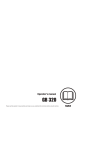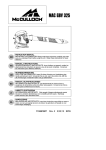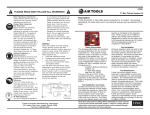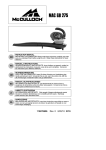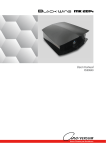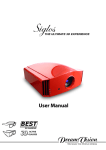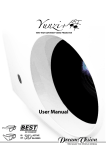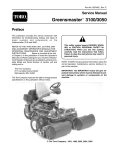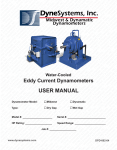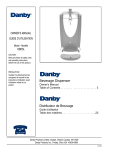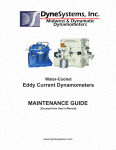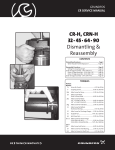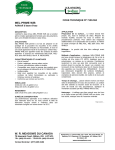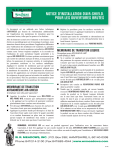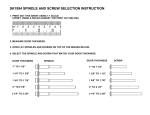Download SERVICE MANUAL
Transcript
SERVICE MANUAL Instructions for the Use and Care of Precision SETCO Spindles Publication: Date of Issue: Issued By: R-0007-5 May 27, 2008 SETCO Sales Company 5880 Hillside Avenue Cincinnati, Ohio 45233 513-941-5110 Publication No. R-0007-5-final May 27, 2008 PREFACE SETCO spindles are super precision components that require the highest level of care and handling. All SETCO precision spindles are manufactured to the highest quality having passed inspection, testing and run-off procedures prior to shipment. Compliance with the recommended care and handling procedures will ensure long spindle life, reliability and the highest quality of performance when placed into service. The purpose of this precision spindle care and handling manual is to assist in the proper handling, installation, operation and maintenance of the precision spindle assembly. Some precision spindles are complex systems, which require auxiliary support equipment for complete operation of the spindle. A thorough background of the precision spindle assembly functionality and the operating parameters of its auxiliary support equipment is strongly recommended prior to putting the spindle into service. Therefore, SETCO recommends that the precision spindle assembly be maintained and operated by well-trained and qualified personnel. FAILURE TO COMPLY WITH THE PROCEDURES AND SPECIFICATIONS CONTAINED IN THIS DOCUMENT MAY RESULT IN SPINDLE FAILURE, PERSONAL INJURY AND/OR VOIDING OF THE SPINDLE WARRANTY KEEP ALL UNAUTHORIZED PERSONNEL AWAY FROM SPINDLE ASSEMBLY AND/OR ITS COMPONENTS. DISCLAIMER The products described in this publication may employ or create hazardous conditions that could through misuse, inattention, or lack of understanding, result in damage to the product or to the equipment, or result in personal injury. It is imperative, therefore, that personnel involved in the handling, installation, maintenance, or use of this product read, understand and comply to the operation of the product and the contents of this publication. This document is based on information available at the time of its publication. While efforts have been made to be accurate, the information contained herein does not intend to cover all details or variations of the products, nor to provide for every possible contingency in connection with handling, installation, operation, or maintenance. Features may be described herein, which are not present in or on all products. SETCO assumes no obligation of notice to holders of this document with respect to changes subsequently made. SETCO makes no representation or warranty, expressed, implied, or statutory with respect to, and assumes no responsibility for the accuracy, completeness, sufficiency, or usefulness of the information contained herein. No warranties of merchantability or fitness for purposes shall apply. No part of this document may be reproduced or transmitted in any form or by means, electronic or mechanical, for any purpose, without the express written permission of the SETCO Corporate Office. Do to continual improvement, specifications are subject to change without notice. For most current specifications, visit our website: setcousa.com © 2007 SETCO Sales Company SETCO™, AIRSHIELD™, and GOLD LINE™ are trademarks of the SETCO Sales Company. i Publication No. R-0007-5-final May 27, 2008 Table of Contents SAFTEY PRECAUTION.......................................................................................................... 1 GENERAL SAFEGUARDS ..................................................................................................... 2 UNCRATING THE SPINDLE .................................................................................................. 4 LIFTING AND TRANSPORTING ............................................................................................ 5 Block Style Spindle Housings ............................................................................................ 6 Cartridge & Flanged Cartridge Spindle Housings .............................................................. 7 Transporting Spindles........................................................................................................ 7 MOUNTING THE SPINDLE .................................................................................................... 8 Mounting Accessories ....................................................................................................... 9 START UP AND RUN IN PROCEDURES ............................................................................ 10 Initial Start up and Break-in Procedure............................................................................ 10 Start Up Procedure for an Idle Spindle 1-Week or More ................................................. 11 Daily Run-In Procedure ................................................................................................... 11 Abbreviated Run-in Procedure for a Spindle with 1/2 - 2 hours of Idle Time ................... 11 STORAGE ............................................................................................................................. 12 Ambient Conditions, Storage ........................................................................................... 12 LUBRICATION ...................................................................................................................... 13 Grease Lubrication .......................................................................................................... 13 Air/Oil Lubrication ............................................................................................................ 13 Air Quality Specification for Air/Oil Lubrication ................................................................... 14 Setup Recommendations ......................................................................................................... 14 Procedure to connect the air/oil lubrication system ................................................................. 15 Oil Lubrication.................................................................................................................. 16 SEALING .............................................................................................................................. 17 Air Purge.......................................................................................................................... 17 Air Quality Specification for Air Purge Sealing...................................................................... 17 Procedure to Connect the Air Purge System ........................................................................... 18 Bearing Isolators.............................................................................................................. 19 Recommendations for Spindles Arranged with Bearing Isolators........................................... 19 Positive Internal Pressure (PIP) System ......................................................................... 20 Air Quality Requirements........................................................................................................ 20 Procedure to Connect a Positive Internal Air Purge (PIP) System .......................................... 21 SETCO AirShieldTM (SAS and USAS) ............................................................................. 22 Procedure to Connect the SETCO AirShield (SAS and USAS*) System ............................... 24 VIBRATION MEASUREMENT.............................................................................................. 25 Instrumentation and Equipment ....................................................................................... 25 Testing Procedure .................................................................................................................... 26 Vibration Transducers ..................................................................................................... 26 Magnet Mounted Transducer .......................................................................................... 26 Stud Mounted Transducer ............................................................................................... 26 Data Collection ................................................................................................................ 27 Baseline Signature ................................................................................................................... 28 ELECTRICAL CONNECTIONS ............................................................................................ 29 Supply Disconnecting Device .......................................................................................... 29 HYDRAULIC AND PNEUMATIC ACCESSORIES ............................................................... 30 ii Publication No. R-0007-5-final May 27, 2008 COOLING ............................................................................................................................ 31 Coolant Requirements – General Conditions ................................................................ 31 Setup Recommendations .............................................................................................. 32 Bearing Cooling ............................................................................................................. 32 Clustered Spindle Cooling ............................................................................................. 34 TRANSPORTING AND OPERATING CONDITIONS ......................................................... 35 Ambient Conditions, Transporting ................................................................................. 35 Ambient Conditions, Operation ...................................................................................... 35 PERIODIC MAINTENANCE................................................................................................ 36 Coolant Management .................................................................................................... 36 Belt Tensioning .............................................................................................................. 37 Lubrication ..................................................................................................................... 38 Drawbar Maintenance ................................................................................................... 38 Dry Floor and Tunnel Guarding ..................................................................................... 38 General Considerations ................................................................................................. 39 TROUBLESHOOTING ........................................................................................................ 40 PRODUCT SUPPORT ........................................................................................................ 41 SETCO Service Locations ............................................................................................. 41 Notes iii Publication No. R-0007-5-final May 27, 2008 SAFTEY PRECAUTION WARNING: DISCONNECT ELECTRICAL POWER WHEN PERFORMING MAINTENANCE OR SERVICE ON EQUIPMENT! THIS INCLUDES: ♦ WHEN ADJUSTING OR CHANGING TOOLS ♦ WHEN MAKING MECHANICAL ADJUSTMENTS ♦ WHEN PERFORMING MAINTENANCE WORK OR PERFORMING ANY SERVICE TO THE SPINDLE ♦ WHEN REMOVING ANY GUARD ♦ WHEN REMOVING ANY BELTS OR PULLEYS TO AVOID INJURY, ELECTRICL POWER MUST BE OFF WHEN PERFORMING MAINTENANCE OR SERVICE ON EQUIPMENT! SERIOUS PERSONAL INJURY IS ALWAYS A HAZARD IN AN INDUSTRIAL ENVIRONMENT. EXTREME CAUTION, IN ALL FACETS OF SAFETY, SHALL BE MAINTAINED. ALL COMPANY SAFETY STANDARDS, PRECAUTIONS AND REGULATIONS OF O.S.H.A. SHALL BE MAINTAINED DURING TRAINING, ASSEMBLY, AND DISASSEMBLY OF PRECISION SPINDLES. 1 Publication No. R-0007-5-final May 27, 2008 GENERAL SAFEGUARDS DO NOT OPERATE THE SPINDLE ASSEMBLY AND/OR ITS COMPONENTS UNLESS YOU HAVE READ THIS DOCUMENT. RETAIN FOR FUTURE REFERENCE. FOLLOW ALL WARNINGS AND INSTRUCTIONS MARKED ON THE SPINDLE ASSEMBLY AND/OR ITS COMPONENTS. 1. Read Instructions Read all the safety and operating instructions prior to operating a precision spindle assembly and/or its components. 2. Retain Instructions The safety and operating instructions of the precision spindle assembly and/or its components should be adhered to. These documents should be retained for future reference. 3. Heed Warnings All warnings on the precision spindle assembly, its components, and operating instructions should be adhered to. 4. Follow Instructions All operating and user instructions of the precision spindle assembly and/or its components should be followed. 5. Attachments and Equipment Never add any attachments and/or equipment to the precision spindle assembly without approval of the manufacturer as such additions may result in spindle failure, personal injury and/or voiding of the warranty. 6. Servicing Do not attempt to service the precision spindle assembly and/or its components yourself as opening or removing covers and/or guards may expose you to dangerous hazards. Refer all servicing to qualified service personnel. 7. Power Disconnect all power to the precision spindle assembly and/or its components before any maintenance. 8. Interlocks Do not by-pass any protective interlocks built into the spindle assembly and/or its components. Disabling of interlocks may result in spindle failure, personal injury and/or voiding of the warranty. 2 Publication No. R-0007-5-final May 27, 2008 9. Protection Always wear proper eye, foot and head protection when lifting, transporting and/or operating any machinery. 10. Water and Moisture Unless approved by the manufacturer, do not use the precision spindle assembly and/or its components where they become immersed in water. The spindle assembly and/or its components are designed to function in moderate coolant applications. 11. Accessories Any mounting of the spindle assembly and/or its components should follow the manufacturer’s instructions, and should use a mounting accessory recommended by the manufacturer, if applicable. 12. Handling the Spindle Do not place the spindle assembly and/or its components on an unstable cart, stand, tripod, bracket or table. The spindle assembly and/or its components may fall, causing serious personal injury and serious damage to the spindle assembly and/or its components. A SPINDLE ASSEMBLY AND CART COMBINATION SHOULD BE USED WITH CARE. QUICK STOPS, EXCESSIVE FORCE, AND UNEVEN SURFACES MAY CAUSE THE SPINDLE ASSEMBLY AND CART COMBINATION TO OVERTURN. 13. Overloading Do not overload the precision spindle assembly and/or its components. The spindle assembly and/or its components should be operated within their rated capacity. 14. Damage Requiring Service Disconnect all power to the precision spindle assembly and/or its components and refer servicing to qualified service personnel under the following conditions: a. If the spindle assembly and/or its components do not operate normally by following the operating instructions. b. If the spindle assembly and/or its components have been dropped or the shipping crate has been damaged. c. When the spindle assembly and/or its components exhibit a distinct change in performance. d. If the spindle assembly and/or its components have been wrecked. e. If the spindle assembly exhibits a rapid change in operating temperature. f. If the spindle assembly exhibits a rapid change in vibration level. g. If the spindle assembly locks-up and cannot rotate. 3 Publication No. R-0007-5-final May 27, 2008 UNCRATING THE SPINDLE SETCO ships each precision spindle assembly in a highly stable shipping container to prevent damage to the spindle assembly during shipment. The spindle assembly and its components are rigidly fixed to the container using fasteners and/or metal straps. Prior to uncrating do the following: 1. Inspect the shipping container for damage. 2. Report any damage to the trucking company and to SETCO’s Service Team. 3. Document any damage with photographs. As you uncrate your spindle assembly, please check to be sure that along with the spindle assembly and its components, the following items are included: 1. A SETCO Service Manual, this document, provides instructions for the Use and Care of Precision Spindles. See Fig 1. 2. A SETCO Gold Line TCT Certificate verifying tested performance (see fig. 2). 3. Fig. 1 - Use & Care Manual A print of the precision spindle outline/assembly drawing. Uncrating the spindle 1. Remove the fasteners and/or metal straps that secure the spindle assembly to the container during shipment. 2. Retain the lifting devices for lifting and transporting. Fig. 2 - SETCO Goldline Certificate 4 Publication No. R-0007-5-final May 27, 2008 LIFTING AND TRANSPORTING IMPROPER LIFTING OF A SPINDLE ASSEMBLY CAN RESULT IN DAMAGE TO THE EQUIPMENT AND BODILY HARM TO PERSONNEL. Prior to removing the spindle assembly from the shipping container perform the following: 1. Visually inspect the spindle assembly for any damage that may have occurred during shipment. If damage to the spindle is evident, immediately notify the trucking company and SETCO’s service team. 2. Locate the weight of the spindle assembly, which may be found on the outline drawing, the shipping container, and/or the spindle nameplate. 3. Ensure the rated lifting capacity of the hoisting equipment (crane, straps, chains, etc.) is greater than the weight of the spindle and is in good condition. 4. Refer to the spindle outline/assembly drawing for the proper method of lifting the spindle assembly and for the locations and size of the lifting holes. 5. Make sure the spindle assemblies eyebolts, swivel type hoist rings, or lifting bars are fastened securely and match the outline/assembly drawing. (Note: not applicable to cartridge spindles, and flange type cartridge spindles). 6. Pad all sharp edges of the spindle assembly that might come into contact with the lifting straps to ensure that lifting straps are not damaged. NEVER LIFT OR TRANSPORT SPINDLE ASSEMBLY BY ANY OF ITS ROTATING COMPONENTS. DO NOT CARRY LOADS OVERHEAD UNLESS ABSOLUTELY NECESSARY. 5 Publication No. R-0007-5-final May 27, 2008 Block Style Spindle Housings BLOCK STYLE SPINDLE HOUSINGS are designed to be lifted and transported using either eyebolts or swivel type hoist rings (see fig. 3). Spindles that are manufactured to be lifted from the top are arranged with tapped holes in the top of the spindle housing for accepting eyebolts; those that are to be lifted from the side have tapped holes for mounting swivel type hoist rings. Securely fasten the eyebolts (or swivel type hoist rings) to the spindle. Lift and transport the spindle using either a lifting strap or chains (see fig.4) connected to a crane with adequate lifting capacity. Fig. 3 - View of Eyebolt and Swivel Type Hoist Rings Fig. 4 - Use of a Lifting Strap or Lifting Chains 6 Publication No. R-0007-5-final May 27, 2008 Cartridge & Flanged Cartridge Spindle Housings CARTRIDGE AND FLANGED CARTRIDGE SPINDLE HOUSINGS do not have provisions for lifting and transporting using eyebolts or swivel type hoist rings. The proper method for lifting and transporting these types of spindle housing styles is by use of a lifting strap and crane. Wrap the lifting strap around the spindle housing ensuring that the strap does not slip. Ensure that the spindle is securely supported and balanced. Use a crane with adequate lifting capacity to lift and transport the spindle (see fig. 5). SPINDLE ASSEMBLIES WITH MOTOR DRIVE PACKAGES employ the same procedures for lifting and transporting as described for the block style spindle housings. In addition, use a lifting sling, or if provided the lifting eyebolt secured to the motor frame, to provide additional support and balance (see fig. 6). Fig. 5 – Lifting Sling on a Cartridge Spindle. DO NOT LIFT THE SPINDLE ASSEMBLY USING ONLY THE MOTOR FRAME EYEBOLT. THE LIFTING ARRANGEMENT MUST PROVIDE A BALANCED LOAD AND STABLE CONDITION. Transporting Spindles Transporting of the precision spindle assembly for service, or to another facility, requires that attention be paid to the packaging and crating. Guidelines for Transporting a Spindle 1. When a precision spindle assembly is transported, it must be bolted or banded to the container in which it is to be shipped so that damage does not occur. Fig. 6 – Lifting Arrangement for Spindle and Motor Drive Assembly. 2. The spindle assembly must be completely enclosed within the container. 3. The container must properly support the weight of the spindle assembly. 4. All service ports must be plugged when disconnected to prevent contamination from entering the spindle assembly. 5. SETCO recommends shipping of the spindle in its original shipping container. 6. To prevent excessive shear loading on the eyebolt threads, apply lifting load in-line with the eyebolt threads. In other words, the chains or lifting straps should be kept in-line with eyebolt threads and perpendicular to the floor as much as possible. 7 Publication No. R-0007-5-final May 27, 2008 MOUNTING THE SPINDLE Installation of the precision spindle assembly onto the machine must be handled with extreme care. The spindle assembly must not be bumped or dropped to avoid damage. The precision spindle assembly is to be carefully mounted onto the machine using chains or lifting straps and hoisting equipment having adequate lifting capacity. NEVER FORCE A SPINDLE INTO POSITION. A RUNNING OR SLIDING FIT IS RECOMMENDED. NEVER FORCE A CARTRIDGE SPINDLE INTO A HOUSING. WHEN USING POWER LIFTING DEVICES, CARE SHOULD BE TAKEN NOT TO BIND THE SPINDLE. For optimum spindle performance, the mounting surface to which the spindle assembly is to mount must be to the highest quality; including: ♦ ♦ ♦ ♦ ♦ Cleanliness Strength Flatness Surface finish Vibration damping Secure the precision spindle assembly to the mounting surface using the appropriate mounting hole locations, bolt sizes (bolts are not supplied by SETCO) and standard torque values. REFER TO THE SPINDLE OUTLINE/ASSEMBLY DRAWING FOR THE MOUNTING HOLE LOCATIONS, SIZE, AND APPLICATION SPECIFICATIONS. DO NOT OVER-TIGHTEN THE MOUNTING BOLTS. OVER-TIGHTENING OF THE MOUNTING BOLTS WILL DISTORT THE SPINDLE HOUSING RESULTING IN IMMEDIATE SPINDLE FAILURE AND VOIDING OF THE SPINDLE WARRANTY. After mounting is complete, any pneumatic, hydraulic, coolant, or electrical connections to the spindle should be completed, if required. Refer to the spindle outline/assembly drawing for the required spindle services and the related specifications. 8 Publication No. R-0007-5-final May 27, 2008 Mounting Accessories ROTATING COOLANT UNIONS are typically mounted on the rear of the precision spindle assembly to provide coolant through the spindle shaft. Use the following procedures for installation of the rotating coolant union as a guide. Superseded by rotating coolant union manufacturer’s installation instructions. Refer to manufacturer’s literature for proper installation instructions. ♦ Improper use may result in premature leakage or failure of the coolant union. ♦ Periodically inspect the coolant union for wear and tear, as the seal wears out, the coolant union must be replaced or repaired to avoid the consequence of leakage. ♦ Keep vent holes clear and non-restricted. ♦ Should a drain line be required to redirect leakage, contact the SETCO Service Team or the manufacturer of the coolant union. ♦ Secure the rotating coolant union to the spindle shaft by: o Connect both supply and drain hoses to the union before mounting the union on the spindle. o Thoroughly clean all mounting surfaces before installing the union. o Verify all drain holes run downward continuously. o Insert the male threads of the coolant union into the rear of the spindle shaft. o Using the proper tools on the rotor hex, tighten the rotor threads until the male pilot on the rotor seats on the diameter and the face of the spindle shaft. Verify thread form using outline drawing as reference. ♦ No exterior bracing should be used to prevent the housing of the rotating coolant union from rotating. ♦ Use only flexible connections. DO NOT PIPE SOLID. ♦ Do not install hose taut. ♦ Avoid operation of coolant union at maximum rated pressure with maximum rated speed. If operating conditions are marginal, consult the SETCO Service Team or the coolant manufacturer. ♦ Rotating coolant unions that are equipped with grease fittings or oil cups require periodic lubrication. Contact the coolant union manufacturer for a lubrication guide. ♦ Do not run dry. 9 Publication No. R-0007-5-final May 27, 2008 START UP AND RUN IN PROCEDURES Although each spindle is ran-off at SETCO prior to shipment, it must further be ran-off by the customer prior to being placing in operation. This will ensure proper channeling of the bearing lubrication to prevent excessive bearing temperatures which could result in immediate bearing failure. Prior to spindle start-up and run-in, a check of any auxiliary systems for proper flows, pressures, and temperatures must occur. All of the information, when required, is defined by SETCO outline drawing and described in this section. The run-in procedures are broken down into four sections. The first section should be followed when the spindle is being operated for the first time. The second section should be followed when the spindle is being operated after it has sat idle for a week or more. The third section should be followed when the spindle is being operated after it has sat idle for 24 hours. The fourth section should be followed when the spindle is being operated after it is has sat for a short period of time (1/2 - 2 hours). The following guidelines must be adhered to in order to ensure proper channeling of the bearing grease lubrication. Improper spindle start-up could result in spindle failure. FEDERAL LAW PROHIBITS SHIPMENT OF AN OIL LUBRICATED SPINDLE WITH OIL IN THE RESERVOIR. THEREFORE, ALL SPINDLES MUST BE PROPERLY FILLED BY THE SPINDLE USER PRIOR TO INSTALLATION. Initial Start up and Break-in Procedure 1. Start the heat exchanger, when required, and run coolant throughout the motor coolant passages (and bearing passages, if required) until the temperature stabilizes. See pages 2, 3, 30, 31, 32, 33, and SETCO’s outline drawing for bearing and motor cooling operating cautions and parameters. 2. Verify that all required auxiliary systems are operating properly. AIR/OIL LUBRICATION MUST BE STARTED A MINIMUM OF 15 MINUTES PRIOR TO STARTING THE SPINDLE ASSEMBLY AND MUST REMAIN ON FOR A MINIMUM OF 5 MINUTES AFTER THE SPINDLE HAS STOPPED AND THE COOLANT HAS STOPPED FLOWING. 3. Run the spindle at 25% of the rated speed (as shown on the nameplate) for approximately 1/2 hour. 4. Monitor the temperature of the front and rear bearings. This can be done by taking temperature readings with a pyrometer at various locations around the front and rear housing. If the temperature does not reach 140 degrees Fahrenheit move to the next step. IF THE BEARING TEMPERATURE REACHES 140 DEGREES FAHRENHEIT, OR HIGHER AT ANY TIME DURING THE RUN-IN PROCEDURE, OR THE TEMPERATURE INCREASES MORE THAN 5 DEGREES FAHRENHEIT IN (1) MINUTE, IMMEDIATELY SHUT THE SPINDLE OFF AND ALLOW IT TO COOL TO ROOM TEMPERATURE. ONCE AT ROOM TEMPERATRE, RE-START THE RUN-IN PROCEDURE AT THE STEP AT WHICH IT WAS SHUT DOWN. 10 Publication No. R-0007-5-final May 27, 2008 5. Increase the operating speed of the spindle to 50% of the rated speed for approximately 1/2 hour and repeat the temperature check. 6. Increase the operating speed of the spindle to 75% of the rated speed for approximately 1/2 hour and repeat the temperature check. 7. Increase the operating speed of the spindle to the full rated speed for approximately 1/2 hour and repeat the temperature check. Start Up Procedure for an Idle Spindle 1-Week or More 1. Follow the initial start-up procedure. Daily Run-In Procedure 1. Start the heat exchanger, when required, and run coolant throughout the motor coolant passages (and bearing passages, if required) until the temperature stabilizes. See pages 2, 3, 30, 31, 32, 33 and SETCO’s outline drawing for bearing and motor cooling operating cautions and parameters. 2. Verify that all required auxiliary systems are operating properly. 3. Run the spindle at 50% of the rated speed (as shown on the nameplate) for ten (10) minutes and check the front and rear bearing temperatures. 4. Start the machine for operation. IF THE BEARING TEMPERATURE REACHES 140 DEGREES FAHRENHEIT, OR HIGHER AT ANY TIME DURING THE RUN-IN PROCEDURE, OR THE TEMPERATURE INCREASES MORE THAN 5 DEGREES FAHRENHEIT IN (1) MINUTE, IMMEDIATELY SHUT THE SPINDLE OFF AND ALLOW IT TO COOL TO ROOM TEMPERATURE. ONCE AT ROOM TEMPERATRE, RE-START THE RUN-IN PROCEDURE AT THE STEP AT WHICH IT WAS SHUT DOWN. Abbreviated Run-in Procedure for a Spindle with 1/2 - 2 hours of Idle Time 1. Start the heat exchanger, when required, and run coolant throughout the motor coolant passages (and bearing passages, if required) until the temperature stabilizes. See pages 2, 3, 30, 31, 32, 33, and SETCO’s outline drawing for bearing and motor cooling operating cautions and parameters. 2. Verify that all required auxiliary systems are operating properly. 3. Run the spindle at 50% of the rated speed for approximately 3-5 minutes and monitor the front and rear bearing temperatures. 4. Start the machine for operation. 11 Publication No. R-0007-5-final May 27, 2008 STORAGE Attention must be given to the spindle assembly when it is not in production. The following guidelines should be followed when the spindle assembly is not in service: 1. The spindle should be stored where it will not be subjected to the danger of bumping or excessive vibration (due to jack hammers, machines, etc.) This phenomenon may cause severe bearing damage when the spindle is not rotating. 2. The spindle storage area should be clean, dry, with a stable temperature of 65° F to 120° F (18° C to 49° C) and non-condensing humidity level. This will help prevent harmful effects of condensation within the spindle. 3. All service ports must be plugged when disconnected to prevent contamination from entering the spindle assembly. 4. SETCO recommends that a log be maintained to ensure proper maintenance of the spindle. 5. Rotate spindles by hand several revolutions each month! REFER TO THE SPINDLE LUBRICATION SECTION FOR ADDITIONAL INFORMATION. Ambient Conditions, Storage Ambient storage conditions refer to the conditions the precision spindle assembly is subjected to during storage. Air Temperature: -40° to +158° F (-40° to +70° C) Relative Humidity: 95% maximum No condensation allowed Atmospheric Pressure: 9 to 15 psi, absolute (0.6 to 1 bar) Vibration: 1.5 mm maximum (2 to 9 Hz), 5 m/s² maximum (9 to 200 Hz) Shock: 100 m/s² maximum, 11 ms 12 Publication No. R-0007-5-final May 27, 2008 LUBRICATION Because of the various applications encountered by a precision spindle assembly, several methods of lubrication are employed. To ensure the successful operation of a precision spindle assembly the importance of the correct type and method of lubrication cannot be over emphasized. Grease Lubrication GREASE LUBRICATION is widely used in a precision spindle assembly since it provides the simplest and most economical method of lubricating bearings while providing some degree of protection against the ingress of coolant and contaminants. Grease lubrication provides: ♦ ♦ ♦ ♦ Maintenance-free operation Does not require re-lubrication Spindles are permanently grease lubricated Lubricated for life. Air/Oil Lubrication AIR/OIL LUBRICATION is an extremely efficient and reliable method for lubricating bearings in a precision spindle assembly while providing some degree of protection against the ingress of coolant and contaminants. It provides a medium-pressure air sealing arrangement to the spindle assembly. The oil lubrication to the spindle bearings is carried by air pressure at approximately 30 psi (2.1 bar). Air/oil lubrication is introduced into the spindle through inlet ports machined into the spindle housing. Typically, there is one port for each bearing in the spindle assembly. REFER TO THE SPINDLE OUTLINE/ASSEMBLY DRAWING AND/OR THE SPINDLE NAMEPLATE FOR THE EXACT AIR AND OIL LUBRICATION SPECIFICATIONS USED IN THE PRECISION SPINDLE ASSEMBLY. REFER TO THE SPINDLE OUTLINE/ASSEMBLY DRAWING FOR THE NUMBER, LOCATION AND SIZE OF THE AIR/OIL LUBRICATION INLET PORTS. DO NOT MISTAKE AIR/OIL LUBRICATION INLETS FOR AIR PURGE, ‘PIP’ OR ‘SAS’ (SETCO AIRSHIELD) INLETS. FAILURE TO COMPLY MAY CAUSE CONTAMINATION AND/OR LACK OF PROPER LIBRICATION OF THE SPINDLE BEARINGS RESULTING IN SPINDLE FAILURE. 13 Publication No. R-0007-5-final May 27, 2008 Air Quality Specification for Air/Oil Lubrication ♦ ♦ ♦ ♦ Inlet air temperature: Inlet dew point temperature (max): Filter Size: Filter efficiency: 70° to 90° F (21° to 32° C) 45° F (7° C) 5.0 micron, maximum 99.99% The recommended air/oil lubrication system consists of: ♦ A quality air/oil lubrication package that includes: ⇒ Pump-manifold-reservoir combination to include outlet check valve, system fill check valve, high-pressure blowout assembly and pressure gauge. ⇒ Controller ⇒ Pneumatic solenoid valve ⇒ Low-level switch ⇒ Panel (optional). ♦ Pre-oil filter ♦ Final oil filter ♦ Divider valve ♦ Cycle switch ♦ Air flow switch ♦ Low-pressure check valve (one per bearing lubrication point). ♦ Air-oil mixing block (one per bearing lubrication point). ♦ Nozzle adapter assembly (one per bearing lubrication point). ♦ Relief valve GENERALLY, NOZZLE TUBES ARE NOT REQUIRED IN THAT THE OIL RESTRICTION TO THE BEARING IS MACHINED INTO THE BEARING SPACERS. Setup Recommendations ♦ Spindle drain holes must be oriented toward the ground. ♦ Properly seal all hydraulic, pneumatic and electrical connections. Seals and gaskets can be susceptible to coolant ingress if not properly secured, or if the sealing deteriorates over time. ♦ All threads of hydraulic, pneumatic and electrical fittings are to be sealed with pipe sealant when connected. ♦ Do not use pipe tape. 14 Publication No. R-0007-5-final May 27, 2008 Procedure to connect the air/oil lubrication system REFER TO AIR/OIL LUBRICATION UNIT MANUFACTURER’S INSTALLATION PROCEDURES FOR MORE COMPLETE INSTRUCTIONS. 1. Mount panel in a convenient location near the spindle assembly for accessible service. 2. Make all required electrical connections. 3. Select monitoring time. 4. Select lubrication cycle time. 5. Make all required pneumatic connections. 6. Set pressure regulator for the pump and the air-oil mixing blocks. 7. Fill reservoir with oil. 8. Install lube lines to lube bearing ports, but do not connect. 9. Purge the system. 10. Start the air/oil lubrication system. AIR/OIL LUBRICATION MUST BE STARTED A MINIMUM OF 15 MINUTES PRIOR TO STARTING THE SPINDLE ASSEMBLY AND MUST REMAIN ON FOR A MINIMUM OF 5 MINUTES AFTER THE SPINDLE HAS STOPPED AND THE COOLANT HAS STOPPED DRIPPING. 11. Check the oil lines to ensure that oil has reached the bearing inlets. 12. Connect lube lines to bearing lube ports. 13. Start the spindle assembly. 15 Publication No. R-0007-5-final May 27, 2008 Oil Lubrication OIL LUBRICATION is the more common method of lubricating the gearbox of a precision gear-driven spindle assembly. A typical gear-driven spindle assembly will have the spindle output bearings grease lubricated, while the gear train, input bearings and idler bearings will be oil lubricated. REFER TO THE SPINDLE OUTLINE/ASSEMBLY DRAWING AND/OR THE SPINDLE NAMEPLATE FOR THE RECOMMENDED OIL LUBRICATION SPECIFICATIONS USED IN THE PRECISION SPINDLE ASSEMBLY. FEDERAL LAW PROHIBITS SHIPMENT OF AN OIL LUBRICATED SPINDLE WITH OIL IN THE RESERVOIR. THEREFORE, ALL SPINDLES MUST BE PROPERLY FILLED BY THE SPINDLE USER PRIOR TO INSTALLATION. Oil fill holes are machined into the spindle gearbox and tagged with ‘OIL FILL’ nameplates. The gearbox should be filled to the proper oil level and monitored using the visual sight gauge provided on the spindle housing. REFER TO THE SPINDLE OUTLINE/ASSEMBLY FOR THE NUMBER, SIZE AND LOCATION OF THE OIL FILL HOLES. REFER TO THE SPINDLE OUTLINE/ASSEMBLY FOR OIL TYPE SPECIFICATIONS. SETCO recommends that the gearbox oil be changed every 1000 hours of operation. FAILURE TO COMPLY WITH THE RECOMMENDED LUBRICATION SPECIFICATIONS MAY RESULT IN SPINDLE FAILURE. SPINDLES SHOULD NOT BE STORED WITH THE GEAR OIL LUBRICATION IN THE RESERVOIR. EMPTY ALL OIL FROM THE SPINDLE PRIOR TO STORAGE. 16 Publication No. R-0007-5-final May 27, 2008 SEALING SETCO precision spindles are designed with special sealing arrangements to protect the spindle and its bearings from contamination, coolant ingress and condensation. The most common of these sealing designs are: ♦ Rubbing seal with air purge - a positive contacting type seal. ♦ Mini-maze seal with air purge - a non-contacting metallic type seal. ♦ Bearing isolator - a non-contacting metallic labyrinth type seal. ♦ Positive Internal Pressure (PIP) - a low-pressure air seal. ♦ Air/oil lubrication - a medium-pressure air seal. ♦ SETCO AirShield ™ (SAS) - a SETCO patented air purge seal design. ♦ Ceramic Face Seals - hydrostatic spindles Although spindle assemblies are usually arranged with the same sealing arrangement at the front (nose end) of the spindle and the rear (drive end) of the spindle, there are some applications that require a combination of the above sealing arrangements between the nose end and the drive end. REFER TO THE SPINDLE OUTLINE/ASSEMBLY DRAWING FOR THE TYPE OF SEALING ARRANGEMENT PROVIDED IN THE SPINDLE ASSEMBLY. Air Purge AIR PURGE is positive low-pressure applied to spindles providing an air barrier that protects against coolant ingress and contaminants. Air purge is used in conjunction with a rubbing seal and/or mini-maze seal to provide additional protection to the spindle. This design does NOT allow air to flow directly through the spindle bearings. Air purge is introduced into the spindle through inlet ports in the spindle housing. Some spindle designs, such as; cartridge housing configurations, prohibit the air purge inlets from being in the housing, therefore; the air purge inlets are located in the front and/or rear bearing retainer caps. Also, when equipped, most spindles are arranged with air purge inlets at each end of the spindle. REFER TO THE SPINDLE OUTLINE/ASSEMBLY DRAWING FOR THE NUMBER, LOCATION AND SIZE OF THE AIR PURGE INLETS. AIR PURGE INLETS ARE TAGGED ON THE SPINDLE HOUSING AND/OR THE FRONT AND REAR BEARING RETAINER CAPS WITH ‘AIR PURGE INLET’ NAMEPLATES. DO NOT MISTAKE AIR PURGE INLETS FOR ‘PIP’, AIR/OIL LUBRICATION OR ‘SAS’ INLETS. FAILURE TO COMPLY MAY CAUSE CONTAMINATION OF THE SPINDLE BEARINGS RESULTING IN SPINDLE FAILURE. Air Quality Specification for Air Purge Sealing ♦ ♦ ♦ ♦ ♦ Inlet air temperature: Inlet dew point temperature (maximum): Filter Size: Filter efficiency: Inlet air pressure: 70° to 90° F (21° to 32° C) 45° F (7° C) 5 micron absolute 99.99% 10 to 15 psig at spindle inlet ports (69 to 103 kPa) 17 Publication No. R-0007-5-final May 27, 2008 In addition, the recommended air purge system consists of: ♦ ♦ ♦ ♦ High-pressure air supply system. Regulator (optional). Regulator filter unit (one per spindle assembly). Pressure gauge (one per spindle assembly). Procedure to Connect the Air Purge System REFER TO AIR PURGE UNIT MANUFACTURER’S INSTALLATION PROCEDURES FOR MORE COMPLETE INSTRUCTIONS. 1. Mount manifold and gauge panel in a convenient location on the spindle assembly for accessible service. 2. Make all required pneumatic connections, but do not connect to the spindle. 3. Purge the system. 4. Connect air lines to the spindle. 5. Set pressure regulator. 6. Start the air purge system. AIR PURGE MUST BE STARTED PRIOR TO STARTUP AND/OR EXPOSURE TO CONTAMINATING CONDITIONS; COOLANT, DUST, HUMIDITY, ETC.. FOR SHUT DOWN, AIR PURGE MUST REMAIN ON FOR A MINIMUM OF 30 MINUTES AFTER THE SPINDLE HAS STOPPED AND THE COOLANT HAS STOPPED FLOWING. 7. Check the air lines to ensure that air has reached the air purge inlets. 8. Start the spindle assembly. For precision spindles arranged with air purge, SETCO recommends: ♦ ♦ ♦ ♦ ♦ Air purge must be hooked-up and operational for all spindles arranged with air purge. Only clean, dry shop air should be utilized. Air pressure should be maintained between 10 to 15 psi (69 to 103 kPa) at the spindle inlet port. Air purge must be operating at all times while coolant is flowing. Proper pneumatic fittings and line size must be used for proper air purge operation. 18 Publication No. R-0007-5-final May 27, 2008 Bearing Isolators BEARING ISOLATORS are labyrinth type seals that function as a pump. Should contamination and/or coolant enter the bearing isolator, it pumps it out through various drain ports arranged in the bearing retainer caps and/or the spindle housing. As a result, the spindle drain ports must be kept clear. Spindles arranged with bearing isolators are typically used in conjunction with the PIP sealing arrangement. Recommendations for Spindles Arranged with Bearing Isolators ♦ Drain ports must be oriented toward the ground. ONLY THE DRAIN PORTS ORIENTED TOWARD THE GROUND ARE TO BE OPEN, ALL OTHER DRAIN PORTS MUST BE PLUGGED. REFER TO THE SPINDLE OUTLINE/ASSEMBLY DRAWING FOR EXACT DRAIN PORT LOCATIONS. ♦ Spindles designed with the bearing isolator exposed must have the isolator expulsion port oriented toward ground. ♦ All drain ports must be kept clear and open at all times to allow proper drainage. Clear away all accumulating chips and/or other contamination from the spindle assembly on a regular, periodic basis so that the spindle drain ports are not restricted. SPINDLES ARRANGED WITH BEARING ISOLATORS MUST BE ROTATING AT ALL TIMES WHEN COOLANT IS FLOWING. FAILURE TO COMPLY MAY CAUSE COOLANT INGRESS AND CONTAMINATION RESULTING IN SPINDLE FAILURE. ♦ All SPARE spindles arranged with the bearing isolator sealing arrangement should be checked and mounted for the proper drain port locations. 19 Publication No. R-0007-5-final May 27, 2008 Positive Internal Pressure (PIP) System A Positive Internal Air Pressure system, referred to as PIP, is a low-pressure air seal typically used in conjunction with spindles arranged with bearing isolators. Spindles arranged with air purge or for air/oil lubrication are not arranged with PIP. DO NOT MISTAKE PIP INLETS FOR AIR PURGE INLETS. By applying PIP, a positive low-pressure is created inside the spindle protecting it against condensation and coolant ingress. PIP is highly effective in those environments which contain high humidity and/or excessive coolant. The low-pressure air is directed into the spindle housing between the front and rear bearing arrangements requiring the air to flow through the bearings. REFER TO THE SPINDLE OUTLINE/ASSEMBLY DRAWING FOR THE PIP INLET LOCATION AND SIZE. TYPICAL PIP INLETS ARE SAE #4 - 7/16-20 THREAD. PIP INLETS ARE TAGGED WITH ‘PIP’ ON THE SPINDLE HOUSING. Since the air must flow through the spindle bearings, special air quality requirements must be maintained. Air Quality Requirements ♦ Air inlet pressure between 1 and 3 psi ( 0.07 to 0.21 bar) at the spindle inlet port. ♦ Air pressure settings are determined for each spindle during run-in at SETCO. Refer to the spindle nameplate for the recommended air pressure setting. ♦ Air pressure must be monitored directly at the spindle inlet and not at the regulator. ♦ Dew point level no greater than 32° F (0° C) at the spindle. ♦ Filter rating at 5.0 micron, absolute. ♦ Inlet air temperature of 70° to 80° F (21° to 27° C). ♦ Estimated air flow of 4 scfm per spindle. ♦ Filter Efficiency: 99.99% AIR QUALITY SPECIFICATIONS MUST BE MAINTAINED. FAILURE TO COMPLY MAY CAUSE COOLANT INGRESS AND CONTAMINATION RESULTING IN SPINDLE FAILURE AIR PURGE TYPE SEAL SYSTEMS SHOULD NOT BE OPERATED IN AN ENCAPSULATE STRUCTURE THAT CHOKES AIR FLOW FROM THE SEAL(S). THIS TYPE OF ENVIRONMENT STOPS AIR FLOW AND THE SPINDLE SEAL SYSTEMS WILL NOT OPERATE AS DESIGNS. FAILURE TO FOLLOW THIS CAUTION MAY CAUSE SPINDLE COMPONENT FAILURE AND VOID THE WARRANTY. 20 Publication No. R-0007-5-final May 27, 2008 Procedure to Connect a Positive Internal Air Purge (PIP) System REFER TO AIR PURGE UNIT MANUFACTURER’S INSTALLATION PROCEDURES FOR MORE COMPLETE INSTRUCTIONS. 1. Mount manifold and gauge panel in a convenient location on the spindle assembly for accessible service. 2. Run the required pneumatic connection, but do not connect to the spindle. 3. Purge the system. 4. Connect air line to the spindle. 5. Set pressure regulator. 6. Start the air purge system. AIR PURGE MUST BE STARTED PRIOR TO STARTUP AND/OR EXPOSURE TO CONTAMINATING CONDITIONS; COOLANT, DUST, HUMIDITY, ETC.. FOR SHUT DOWN, AIR PURGE MUST REMAIN ON FOR A MINIMUM OF 30 MINUTES AFTER THE SPINDLE HAS STOPPED AND THE COOLANT HAS STOPPED FLOWING. 7. Check the air line to ensure that air has reached the air purge inlet. 8. Start the spindle assembly. 21 Publication No. R-0007-5-final May 27, 2008 SETCO AirShieldTM (SAS and USAS) The SETCO AirShield (SAS) is a patented spindle air-purge seal system that uses regulated air pressure to “back pressure” a flexible lip seal to prevent contaminants and coolant ingress from entering the spindle. SETCO also offers a compact version of the AirShield called the Universal SETCO AirShield. See Fig. 8 below. The USAS design offers a smaller cross and can be used retrofit seal of spindle designs with cloe center distances. The USAS provides the same sealing qualities as the original SAS design. The USAS provides a precision machined steel housing that encases the flexible lip seal in the stator (stationary) section. A rotor (or rotating cap provides the sealing surface for the lip seal. Different from a PIP system, which utilizes a labyrinth type seal, the SAS and USAS systems use a stationary lip seal secured to the bearing end cap. With the spindle stopped, and with air purge off (no air flow), the lip seal forms a positive seal between the spindle arbor and the end cap. When air pressure is applied, escaping air lifts the seal face creating minimal backpressure and forming a near frictionless seal as the spindle rotates. Fig. 7 – Diagram of the Patented SETCO AirShield ™ Two beveled surfaces, outside of the seal lip, see figure 7, form a uniform air-purge generator as the spindle rotates. As the flood coolant pressures increase, additional pressure is applied to the sealing face, further increasing the effectiveness of the SAS and USAS systems. The air pressure maintains minimal clearance to prevent the lip seal from wearing. Fig. 8 – View of the Patented Universal SETCO AirSheld Design (USAS) 22 Publication No. R-0007-5-final May 27, 2008 Air Quality Specification for SAS and USAS Sealing ♦ Inlet air temperature: ♦ Inlet dew point temperature (maximum): 70° to 90° F (21° to 32° C) DP oF = Ambient Temp o F = -20o F Not to Exceed 50o F DP oC = Ambient Temp oC = -11o C Not to Exceed 10o C 5 micron, absolute 99.99% 10 to 15 psig at spindle inlet ports (69 to 103 kPa) ♦ Filter Size: ♦ Filter efficiency: ♦ Inlet air pressure: AIR INLET PRESSURES MUST BE MAINTAINED AT EACH END OF THE SPINDLE INLET PORTS. SUFFICIENT AIR VOLUME (CFM) MUST BE ESTABLISHED TO MAINTAIN AIR PRESSURE. REFER TO THE SPINDLE OUTLINE DRAWING FOR SPECIFIC PORT LOCATIONS AND ESTIMATED FLOW REQUIREMENTS. AIR QUALITY SPECIFICATIONS MUST BE MAINTAINED. FAILURE TO COMPLY MAY CAUSE COOLANT INGRESS AND CONTAMINATION RESULTING IN SPINDLE FAILURE. THE AIRSHIELD IS AN AIR PURGE TYPE SEAL SYSTEM. DO NOT ENCAPSULATE THE SPINDLE IN A STRUCTURE THAT CHOKES AIR FLOW FROM THE SEAL(S). ENCAPSULATION MAY CAUSE SPINDLE COMPONENT FAILURE AND VOID THE WARRANTY. 23 Publication No. R-0007-5-final May 27, 2008 Procedure to Connect the SETCO AirShield (SAS and USAS*) System 1. Mount manifold and gauge panel in a convenient location on the spindle assembly for accessible service. 2. Make all required pneumatic connections, but do not connect to the spindle. 3. Purge the system. 4. Connect air lines to the spindle. 5. Set pressure regulator. 6. Start the air purge system. AIR PURGE MUST BE STARTED PRIOR TO STARTUP AND/OR EXPOSURE TO CONTAMINATING CONDITIONS; COOLANT, DUST, HUMIDITY, ETC.. FOR SHUT DOWN, AIR PURGE MUST REMAIN ON FOR A MINIMUM OF 30 MINUTES AFTER THE SPINDLE HAS STOPPED AND THE COOLANT HAS STOPPED FLOWING. 7. Check the air lines to ensure that air has reached the air purge inlets. 8. Start the spindle assembly. SPECIAL GUARDING AND/OR ENCLOSURES. SPINDLES EQUIPPED WITH THE SETCO AIRSHIELD REQUIRE NONOBSTRUCTED AREA SURROUNDING THE FRONT AND REAR SHAFT SPINDLE SEAL. DO NOT ENCAPSULATE THE SPINDLE IN A STRUCTURE THAT INHIBITS FREE AIR MOVEMENT FROM THE SPINDLE. ENCAPULATING MAY CAUSE SPINDLE COMPONENT FAILURE AND VOID WARRANTY. Note: *SAS is an abbreviation for the standard Setco AirShield. USAS is an abbreviation for the Universal Setco AirShield. 24 Publication No. R-0007-5-final May 27, 2008 VIBRATION MEASUREMENT Vibration analysis is one of the most valuable tools for qualifying a spindle and for predictive maintenance, when done correctly. Each spindle manufactured by SETCO is qualified through a vibration certification test, which is electronically archived at SETCO. Similar vibration testing should be conducted at the installation site for predictive maintenance information. If proper care and time are taken to attain “good” reliable vibration data, the spindle user can save tremendous amounts of time and money in minimizing their downtime due to catastrophic and unpredicted spindle failures. While the spindle is on the test stand, a vibration signature should be taken. This will establish a baseline reading which can be reasonably compared to SETCO’s reading at the time of shipment. If all the vibration readings are acceptable, the spindle can be mounted in its operating environment. REMEMBER TO TAKE ALL THE PRECAUTIONARY STEPS NOTED IN THIS MANUAL WHILE INSTALLING THE PRECISION SPINDLE TO ENSURE PROPER OPERATION. Once the spindle is mounted on the machine, a second vibration reading should be taken prior to installing any tooling (if possible). If all the vibration readings are acceptable, the tooling can be mounted to the spindle. After the tooling is mounted, a third set of vibration readings should be taken. This reading will serve as a baseline for all future readings. Progressive vibration readings, as detailed above, will allow the analyst to isolate between external spindle vibration and vibration which may be internal to the spindle. Vibration analysis can prove to be an extremely valuable PM (Predictive Maintenance) tool. Vibration data will not exactly duplicate that from SETCO because of different accelerometers, magnets, mounting methods, etc. Instrumentation and Equipment Instrumentation and Equipment required for conducting vibration analysis on a precision spindle assembly is as follows: ♦ Spectrum Analyzer ♦ Vibration Transducer ♦ Vibration Test Stand FFT - Fast Fourier Transform 0-10kHz range for most spindles Spindle should be analyzed on a test stand with known resonance properties. AVOID TAKING VIBRATION MEASUREMENTS ON A SPINDLE MOUNTED TO A TEST STAND THAT HAS A RESONANCE NEAR EITHER THE SPINDLE OR MOTOR SPEED. ♦ Clamp-on current probe for recording amperage draw in the spectrum analyzer for motorized spindles. 25 Publication No. R-0007-5-final May 27, 2008 Testing Procedure Testing Procedure should consist of vibration measurements taken in the directions and locations as stated below, where possible: ♦ Horizontal direction – for block spindles, perpendicular to the axis of rotation and parallel to the mounting surface. ♦ Vertical direction – for block spindles, perpendicular to the axis of rotation and perpendicular to the mounting surface. ♦ Axial direction - parallel to the axis of rotation and parallel to the mounting surface. TO MINIMIZE VIBRATION AND IMPROVE PERFORMANCE, ALL TOOL ASSEMBLIES SHOULD BE BALANCED! Vibration Transducers Vibration Transducers affixed to the precision spindle assembly can be magnet-mounted or stud-type mount. If it is suspected that magnet resonance is affecting the measurements, try using the stud-mounted transducer. Magnet Mounted Transducer ♦ Should have the appropriate geometric magnet to assure proper contact with the mounting surface of the spindle. ♦ A flat rare-earth magnet should be used when the transducer mounting location is on a flat surface. ♦ A two-rail magnet must be used when the transducer mounting location is a round surface. Do not use a flat rare-earth magnet. ♦ The two-rail magnet must be firmly attached to the spindle to eliminate “rocking”. Stud Mounted Transducer ♦ Should be mounted on a smooth, flat surface, at least the size of the transducer base. ♦ A tapped hole should be used to secure the transducer to the spindle housing, with enough threads to allow the transducer conducting surfaces to be tighten down without the threads bottoming out. Transducer Mounting Surface Preparation is extremely important to assure repeatable vibration measurements. ♦ The transducer mounting surface should be flat with a smooth surface finish for best results. ♦ The transducer mounting surface should be clean and free of metal burrs, or any other foreign particles that may interfere with the contacting surfaces. ♦ Do not mount the transducer to a painted surface. ♦ Do not mount the transducer to a rough surface. 26 Publication No. R-0007-5-final May 27, 2008 Transducer Mounting Preparation: ♦ Apply a thin layer of silicone grease between the accelerometer and the magnet and between the magnet and the mounting surface. This will help fill the microscopic voids between surfaces, allowing better transmission of the vibration signal. ♦ Unless otherwise specified by the transducer manufacturer, use a torque specification of 40 in-lb (4.5 Nm) when attaching the accelerometer to the magnet or when stud-mounting it to the spindle surface. Most SETCO spindles manufactured with the block style housing provide vibration transducer mounting locations over the front and rear spindle bearings for vibration analysis. These machined surfaces, arranged with a tapped hole, will accommodate either magnet-mounted or stud-mounted vibration transducers. Data Collection Data Collection should be recorded using a spectrum analyzer and a magnet-mounted transducer at horizontal, vertical and axial directions in each bearing plane, where possible. ♦ Data should be taken at maximum spindle operating speed. ♦ Data should be taken with the spindle at its steady state operating temperature. ♦ For a motorized spindle, amperage draw should be recorded using a clamp-on current probe for all phases of the motor. AVOID OPERATING THE SPINDLE AND/OR DRIVE MOTOR AT OTHER SYSTEM COMPONENT (TEST STAND, MACHINE PLATEN, V-BLOCKS, MOUNTING BRACKETS. ETC.) RESONANT FREQUENCIES THAT WILL CAUSE THE VIBRATION DATA TO BE HEAVILY AMPLIFIED. 27 Publication No. R-0007-5-final May 27, 2008 Baseline Signature For comparative data, initial base line vibration signatures should be taken to observe the following conditions: ♦ While the spindle is on the test stand. ♦ When spindle is mounted on the machine (spindle only). ♦ After tooling has been dynamically balanced and mounted to the spindle. REFER TO THE SPINDLE START-UP AND RUN-IN SECTION OF THIS DOCUMENT. These vibration signatures will allow for baseline readings to be established which could be used by a vibration analyst to determine the trend of and future spindle conditions. Once the spindle is in production, it is recommended that vibration signatures be taken: ♦ Approximately once a month for the first three (3) months to provide trend information. This will serve as a comparative tool to the previous baseline signatures. ♦ After this three-month period, vibration readings can be reduced to approximately once every two (2) or three (3) months. Documentation of all vibration measurements taken on the precision spindle assembly is extremely important. This data can be analyzed and compared to previous measurements to predict scheduled downtime and spindle servicing. It also can be used to diagnosis the spindle condition and determine the possible cause of spindle failure. 28 Publication No. R-0007-5-final May 27, 2008 ELECTRICAL CONNECTIONS Supply Disconnecting Device TURN OFF ALL ELECTRICAL POWER BEFORE OPENING GUARDS OR PERFORMING MAINTENANCE OR SERVICING EQUIPMENT. REFER TO THE SAFETY SECTION OF THIS MANUAL. Spindle motors are not equipped with any electrical disconnect device from the factory. A disconnect device must be installed in each power supply circuit. The disconnecting device must be one of the following types: ♦ A switch disconnector. ♦ A disconnector which has an auxiliary contact which in all cases causes switching devices to break the load circuit before opening of the main contacts of the disconnector. ♦ A circuit breaker suitable for isolation. The supply cable must be according to state and local safety regulations and capable of carrying the total RMS input current. Power cables should be installed away from and separate from signal processing cables. Use shielded cable for all control and signal processing equipment. Prior to making any electrical connections, verify that the motor power connector is compatible with the connection on the rear of the spindle. REFER TO THE SPINDLE OUTLINE/ASSEMBLY DRAWING FOR LOCATION AND SIZE AND/OR DESIGNATION OF THE CONNECTOR. REFER TO THE SPINDLE ELECTRICAL CONNECTION AREA FOR THE PROPER WIRING DIAGRAM. ALL ELECTRICAL CONNECTIONS MUST BE WATERTIGHT CONNECTIONS. After verifying that all mating connectors are correct, carefully insert the plug into its proper location and tighten down on the receptacle to insure a ‘good’ electrical connection is established. LOOSE CONNECTIONS MAY RESULT IN IMPROPER SPINDLE OPERATION AND POSSIBLE MOTOR DAMAGE. SETCO recommends that all threaded electrical fittings be sealed with pipe thread sealant and that all gasketing material be made of ‘VITON’. Improperly sealed connections may result in motor shortouts and spindle bearing failure due to coolant ingress. 29 Publication No. R-0007-5-final May 27, 2008 HYDRAULIC AND PNEUMATIC ACCESSORIES If the spindle is equipped with a power drawbar, connections must be made prior to spindle operation. Hydraulic and air connections are made through a rotary union located at the rear of the spindle. Continuous hydraulic or air pressure is supplied to the union during spindle rotation. SPINDLES EQUIPPED WITH A DRAWBAR MUST NEVER OPERATE UNDER POWER WITHOUT A TOOL HOLDER OR TOOL PLUG CLAMPED BY THE DRAWBAR. HYDRAULIC UN-CLAMPING PRESSURE SHOULD ONLY BE APPLIED AT SPINDLE STANDSTILL. NEVER UN-CLAMP THE DRAWBAR WHILE THE SPINDLE IS ROTATING. RESIDUAL LINE PRESSURE SHOULD NEVER EXCEED 5 PSI (0.5 BAR). HIGHER PRESSURE MAY RESULT IN HYDRAULIC OIL LEAKAGE AND MAY CAUSE DAMAGE TO THE ROTARY UNION. FAILURE TO FOLLOW THE INSTRUCTIONS ABOVE MAY RESULT OF PERSONAL INJURY OR DAMAGE TO EQUIPMENT. ♦ Hydraulic lines must be flexible and must not load the rotary union. ♦ The hydraulic pressure must be within recommended operating range. ♦ The spindle must never be rotated without the tool clamped to avoid spindle system damage and severe personal injury. ♦ The recommended filtration for all hydraulic fluids is 10 microns. IF POWER DRAWBAR IS EQUIPPED WITH A COOLANT UNION, COOLANT MUST BE FLOWING WHEN ARBOR IS ROTATING. 30 Publication No. R-0007-5-final May 27, 2008 COOLING Various precision spindle assemblies, such as; liquid cooled motorized spindles, require additional cooling to dissipate heat. In addition, various clustered spindle assemblies require recirculating cooling for temperature control of the spindle housing to maintain the centerline-to-centerline relationship of the spindle pattern. These spindles are arranged with internal recirculating cooling by either a cooling jacket and/or a continuous serpentine cooling groove machined in the spindle housing. Coolant Requirements – General Conditions ♦ ♦ ♦ ♦ ♦ Inlet temperature: Coolant mixture: Filter size: Filter efficiency: Inlet pressure: 80° to 85° F (27° to 29° C) 80% water and 20% Glycol 25 microns absolute 99.99% 425 psi maximum (2940 kPa) MOTOR COOLING of a precision liquid-cooled motorized spindle assembly is employed to dissipate motor heat from the motor stator providing better spindle performance. This arrangement consists of recirculating coolant throughout the spindle housing and around the motor stator. REFER TO THE SPINDLE OUTLINE/ASSEMBLY DRAWING FOR RECOMMENDED COOLING REQUIREMENTS AND SPECIFICATIONS. Cooling ports are machined into the spindle housing and are tagged with ‘MOTOR COOLANT INLET’ and ‘MOTOR COOLANT OUTLET’ nameplates. REFER TO THE SPINDLE OUTLINE/ASSEMBLY DRAWING FOR LOCATION AND SIZE OF COOLING PORTS. 31 Publication No. R-0007-5-final May 27, 2008 Setup Recommendations For a liquid-cooled motorized spindle that requires cooling of the motor: ♦ Use a quality closed-loop refrigeration unit for best performance. ¾ Use the recommended installation and operating procedures provided by the manufacturer of the refrigeration unit. ♦ To avoid thermal shock to the spindle assembly, coolant flow cannot be completely stopped and then restarted while the spindle is rotating. ♦ Motor cooling ports must be connected separately from bearing cooling ports, unless specifically stated on the spindle outline/assembly drawing. ♦ All coolant return lines must be free flowing back to the refrigeration unit with no line restrictions or blockages. ♦ Coolant temperatures must be within stated limits to avoid condensation and thermal shock to the spindle assembly. ♦ All threaded connections and fittings must be sealed with pipe sealant. Bearing Cooling BEARING COOLING of a precision spindle assembly is employed to maintain a constant spindle temperature by recirculating coolant around the front spindle bearings. This arrangement consists of recirculating coolant through the spindle housing and/or front-end bell and around the front bearing arrangement. REFER TO THE SPINDLE OUTLINE/ASSEMBLY DRAWING FOR RECOMMENDED COOLING REQUIREMENTS AND SPECIFICATIONS. Cooling ports are machined into the spindle housing and are tagged with ‘BEARING COOLANT INLET’ and ‘BEARING COOLANT OUTLET’ nameplates. REFER TO THE SPINDLE OUTLINE/ASSEMBLY DRAWING FOR LOCATION AND SIZE OF COOLING PORTS. 32 Publication No. R-0007-5-final May 27, 2008 For a precision spindle which requires cooling of the spindle bearings: ♦ Use a quality closed-loop refrigeration unit for best performance. ¾ Use the recommended installation and operating procedures provided by the manufacturer of the refrigeration unit. ♦ To avoid thermal shock to the spindle assembly, coolant flow cannot be completely stopped and then restarted while the spindle is rotating. ♦ Bearing cooling ports must be connected separately from motor cooling ports, unless specifically stated on the spindle outline/assembly drawing. ♦ All coolant return lines must be free flowing back to the refrigeration unit with no line restrictions or blockages. ♦ Coolant temperatures must be within stated limits to avoid condensation and thermal shock to the spindle assembly. ♦ All threaded connections and fittings must be sealed with pipe sealant. 33 Publication No. R-0007-5-final May 27, 2008 Clustered Spindle Cooling CLUSTERED SPINDLE COOLING is employed for temperature control of the spindle assembly to maintain the centerline-to-centerline relationship of the spindle pattern. This arrangement consists of recirculating coolant throughout the spindle housing. REFER TO THE SPINDLE OUTLINE/ASSEMBLY DRAWING FOR RECOMMENDED COOLING REQUIREMENTS AND SPECIFICATIONS. Cooling ports are machined into the spindle housing and are tagged with ‘ COOLANT INLET’ and ‘COOLANT OUTLET’ nameplates. REFER TO THE SPINDLE OUTLINE/ASSEMBLY DRAWING FOR LOCATION AND SIZE OF COOLING PORTS. For a precision clustered spindle assembly that requires recirculating cooling: ♦ Use a quality closed-loop refrigeration unit for best performance. ¾ Use the recommended installation and operating procedures provided by the manufacturer of the refrigeration unit. ♦ To avoid thermal shock to the spindle assembly, coolant flow cannot be completely stopped and then restarted while the spindle is rotating. ♦ All coolant return lines must be free flowing back to the refrigeration unit with no line restrictions or blockages. ♦ Coolant temperatures must be within stated limits to avoid condensation and thermal shock to the spindle assembly. ♦ All threaded connections and fittings must be sealed with pipe sealant. 34 Publication No. R-0007-5-final May 27, 2008 TRANSPORTING AND OPERATING CONDITIONS Ambient Conditions, Transporting Ambient transporting conditions refer to the conditions the precision spindle assembly is subjected to during transportation. Air Temperature: -40° to +158° F (-40° to +70° C) Relative Humidity: 95% maximum, non-condensing Atmospheric Pressure: 9 to 15 psi (0.6 to 1 bar) Vibration: 3.5 mm maximum (2 to 9 Hz), 15 m/s² maximum (9 to 200 Hz) Shock: 100 m/s² maximum, 11 ms Bump: 300 m/s² maximum, 6 ms Free Fall: Dropping a spindle, in its shipping container (packed) or unpacked, may result in damage that will effect performance and warranty. If dropped a full inspection is required. Consult factory. Ambient Conditions, Operation Ambient operating conditions refer to the conditions the precision spindle assembly is subjected to when installed and running. Air Temperature: 50° to +120° F (10° to +49° C) Consult factory for temperatures exceeding this range. Relative Humidity: 5 to 95%, non-condensing No condensation allowed Vibration: 0.3 mm maximum (2 to 9 Hz), 1 m/s² maximum (9 to 200 Hz) 35 Publication No. R-0007-5-final May 27, 2008 PERIODIC MAINTENANCE Coolant Management Coolant management is an extremely important subject that is often overlooked in the operation of a precision spindle assembly. Coolant ingress to the spindle assembly may cause the bearing lubrication to break down, be washed out, or become contaminated with chips resulting in bearing failure long before its full life expectancy. Although SETCO uses the best sealing methods available to protect the spindle assembly, other factors can considerably reduce the life of a spindle assembly. The following are recommendations by SETCO to improve the spindle environment by coolant management: ♦ Check Cooling Inlet Ports For Leakage And Clean Once A Year ♦ Coolant nozzles must be directed at the tool and/or workpiece and not at the spindle nose. ¾ High-pressure coolant spray directed at the spindle can overcome the spindle sealing arrangement. Refer to the SEALING section of this manual. AIR PURGE / PIP MUST REMAIN ON ANYTIME THE SPINDLE IS RUNNING OR WHEN COOLANT IS FLOWING. FAILURE TO FOLLOW THIS INSTRUCTION MAY RESULT IN SEAL DAMAGE OR BEARING CONTAMINATION. ♦ Clear away all accumulating chips and/or other contamination from the spindle assembly on a regular, periodic basis so that spindle drain holes are not restricted. ♦ All guarding to be designed to prevent coolant from pooling near the spindle drain holes, conduit boxes, electrical connectors, etc. ♦ Cleaning of the machine with high-pressure coolant or steam cleaners must be avoided. Spindles are not designed to be subjected to washing when they are not rotating. ♦ Properly seal all hydraulic, pneumatic and electrical connections. Seals and gaskets can be susceptible to coolant ingress if not properly secured, or if the sealing deteriorates over time. ♦ All threaded connections and fittings must be sealed with pipe sealant. Do NOT use pipe tape. ♦ Spindle should be rotating at all times while coolant is on. ♦ Stop all coolant flow before stopping the spindle. ♦ Start the spindle before starting the coolant. If this is not possible, as in the case of using a rotating coolant union, start the spindle and coolant at the same time. 36 Publication No. R-0007-5-final May 27, 2008 Belt Tensioning A loose belt will slip and not transmit enough power. If the belt has too much tension spindle and motor bearing can be damaged. The illustration (right) shows a typical belt tension instruction plate. If this instruction plate is provided, a belt tension specification for your spindle arrangement is provided. If the no specifications are available, refer to the drive belt manufacturer for recommended belt tension specifications. General Recommendations ♦ Check belt tension periodically during routine maintenance. Adjust as necessary. The illustration (below) shows how to measure arbor deflection as the result of belt tensioning. The examples are provided to show how belt tension should vary with spindle size. ♦ A drive belt should only be as tight as necessary to establish positive transmission of power without slippage. Do not over tighten the drive belt. ♦ If the pulleys are not aligned, premature belt wear, loss of power transmission and poor vibration reading will occur. Check for drive pulley alignment. ♦ After certain motor risers are adjusted, belt tensioning will change as the locking screws are secured. Check the belt tension after locking screws are secured. OVER TIGHTENING A DRIVE BELT CAN CAUSE BEARING OVER LOAD AND EXCESSIVE HEAT. OVER TIGHTENING A DRIVE BELT MAY LEAD TO PREMATURE SPINDLE BEARNG FAILURE. A MODERATE BELT DEFLECTION IS NORMAL; SHORT CENTERLINE DISTANCES HAVE LESS DEFLECTION THAN LONGER SPANS. 37 Publication No. R-0007-5-final May 27, 2008 Lubrication Many machine components require lubrication to function properly. It is important to ensure that all lubrication reservoirs are properly filled and maintained for oil cleanliness. (Refer to SETCO’s outline drawing and the Oil Lubrication section for proper specifications and maintenance instructions.) Note that oil analysis is an excellent tool for trending lubrication condition. For spindles with oil reservoirs, check oil level after installation (before running the spindle), weekly, change every 1000 hours of operation. Drawbar Maintenance Visually inspect for dirt build-up daily. Clean as required. Do not lubricate tool-holding surfaces. Dry Floor and Tunnel Guarding Dry Floor Guarding and Tunnel Guarding are used quite often in the machine tool industry on transfer lines. These types of guarding create an environment with extremely high temperatures and humidity. To reduce the possibility of spindle failure caused by condensation, the following recommendations should be considered: ♦ Utilize a mist collection system to remove excessive moisture from the inside of the machine guarding. ♦ Turn off all coolant sprays (chip wash, coolant through the shaft, etc.) when the spindle is idle or stopped. ♦ Open the guarding door between shifts. This will reduce the internal humidity and prevent moisture from building up inside the enclosed environment. ♦ Where possible, reduce the volume of coolant flow. 38 Publication No. R-0007-5-final May 27, 2008 General Considerations Each spindle assembly is unique in its design and operation. Spindle assemblies are arranged to accept various types of tool holders and accessories. Therefore, the following recommendations should be considered: ♦ Always use proper tools when working on or with the spindle assembly, so as not to cause damage to the spindle housing, spindle internal components and spindle accessories. ♦ Always use a wheel guard, which meets or exceeds the appropriate A.N.S.I. and O.S.H.A. standards when using a grinding wheel with a spindle assembly. ♦ All tooling, tool holders, pulleys, drawbars, coolant unions and couplings must be dynamically balanced to the same specifications as the spindle assembly. Mechanical runouts may result in high vibration levels and must be checked and corrected if necessary. RUNOUTS MUST BE MORE CLOSELY CONTROLLED AT HIGHER SPINDLE SPEEDS. ♦ Do not tighten cold quills in a hot spindle nose taper. Spindle assembly must be cooled to the same temperature as the quill or the quill must be heated to the same temperature as the spindle assembly. Failure to comply may result in over tightening of the quill, which may make it difficult to remove and may result in damage to the spindle nose taper. ♦ Do not operate the spindle assembly at speeds higher than its nameplate rating. If over speeding occurs, the spindle may fail due to excessive temperatures. ♦ Do not operate the spindle assembly at speeds lower that its nameplate rating. If under-speeding occurs, the spindle may not perform properly. CONTACT SETCO’S SERVICE TEAM FOR RECOMMENDATIONS TO OPERATING SPINDLE ASSEMBLY OUTSIDE ITS NAMEPLATE RATING. ♦ Do not operate the spindle assembly with loose screws, nuts, keys or any fasteners. Failure to comply may result in damage to the spindle assembly or personal injury. ♦ Do not bump or hammer on the spindle shaft as this may cause severe damage to the spindle bearings and/or spindle shaft. ♦ Never stand the spindle assembly on the end of the spindle shaft. ♦ Do not lift or transport spindle assembly by its rotating shaft or any component attached to it. ♦ Permanently grease lubricated spindles do not require additional lubrication. ♦ Follow recommended belt tensioning installation procedures. WHEN MOTOR RISERS ARE ADJUSTED, SOME HEIGHT CHANGE MAY OCCUR WHEN LOCKING SCREWS ON THE RISER ARE TIGHTENED. BELT TENSIONING SHOULD BE RECHECKED PRIOR TO INSTALLING THE BELT GUARD. 39 Publication No. R-0007-5-final May 27, 2008 TROUBLESHOOTING TROUBLESHOOTING CHART Problem Problem Cause Corrective Action Redirect coolant flow away from spindle nose. Stop all coolant flow before stopping spindle. Coolant ingress. Start spindle before starting coolant flow, or at the same time. Avoid cleaning the machine with high-pressure coolant, pressure washers or steam cleaners. Lack of or no air purge on spindle. Utilize Positive Internal Pressure (PIP). Condensation. Store spindle in a clean, dry, stable temperature and noncondensing environment. Turn off all coolant flow when spindle is stopped. Open guarding doors between shifts. Contamination Improper direction or pressure from coolant nozzles. Bearing isolator drain port not arranged for attitude of spindle mounting. Improper guarding which does not allow chip or coolant dispersion. Redirect coolant flow away from spindle nose. Reduce coolant flow and pressure. Clean chips away from spindle drain holes. Orient bearing isolator and/or bearing retainer cap so that drain ports are directed toward the ground. Clean chips away from spindle drain holes. Arrange guarding so that coolant is not allowed to pool. Properly seal and secure all connections. Loose or incorrect seal of cover plates and/or electrical connectors. Replace seals and gaskets, if necessary. Seal all threaded connections with pipe sealant. Verify lock-up gap (between front bearing retainer cap and housing) is 0.005" to 0.010" minimum. Loss of preload. Verify bearing lock-up and preload on bearings through front bearing assembly static compliance test. If excess clearance is found, adjust bearing preload. Chatter Improper tool geometry. Check tooling for balance and/or excessive wear. Reduce tool overhang. 40 Publication No. R-0007-5-final May 27, 2008 PRODUCT SUPPORT In the event that the spindle assembly is deteriorating, should fail, or general customer service is needed, the following information should be provided to SETCO’s service team. ♦ Spindle serial number - can be found on the spindle nameplate or etched on the spindle housing. ♦ Order number that the spindle was manufactured on - can be found on the spindle nameplate or on the spindle outline/assembly drawing the order number is the last five digits (suffix) of the type/model number. ♦ SETCO’s spindle type - as with the order number - the spindle type is the prefix of the type/model number. ♦ Description of the current problem. ♦ History of any predictive maintenance related to that spindle, such as; vibration analysis, maintenance log, etc. SETCO Service Locations United States Great Lakes Service Center Novi, Michigan 48375 Toll Free: 1-877-773-5349 Midwest Service Center Cincinnati, Ohio 45233 Toll Free: 1-800-543-0470 SouthEast SETCO Service Center Suwanee, GA 30024 Toll Free: 1-800-830-4992 Western Service Center Huntington Beach, California 92649 Toll Free 1-866-362-0699 England SIEMENS Cheshire, England SK9 3PR Phone: (011) 44-1625-543-480 For additional information, visit our website: www.setcousa.com 41














































